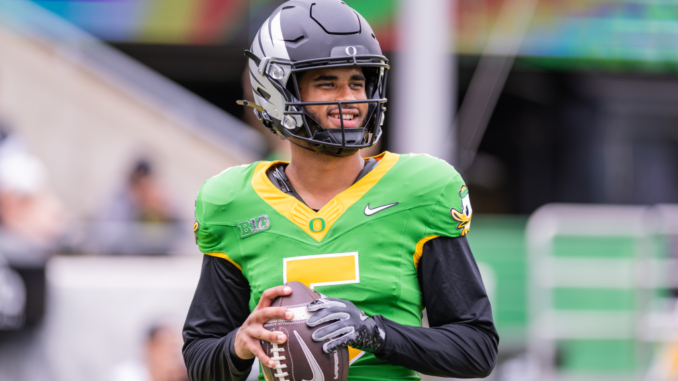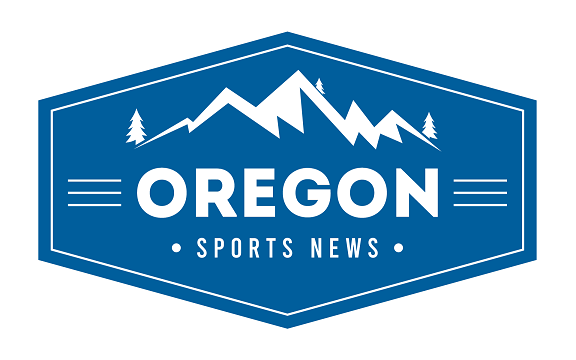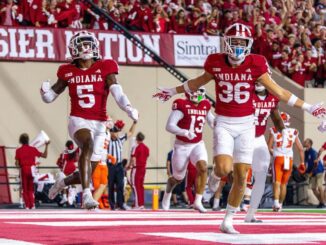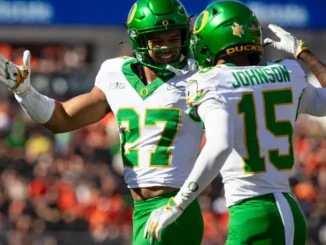
When Dan Lanning arrived in Eugene in 2022, most headlines were about his defensive pedigree. The architect of Georgia’s national title defense was expected to bring toughness and discipline to a program already known for speed and flair. Yet, quietly and perhaps more surprisingly, Oregon has become something else under Lanning’s guidance: a quarterback finishing school.
This was not the narrative at the time of his hiring. Oregon had struggled to sustain consistency at quarterback after Justin Herbert, shuffling through Anthony Brown and a revolving door of transfers. The Ducks were viewed as a launching pad for skill players and flashy uniforms rather than a home for quarterbacks. That changed when Lanning and his staff began not just recruiting talent but reviving careers.
Bo Nix, once written off at Auburn, became a Heisman finalist and first-round pick after two seasons in Eugene. Dillon Gabriel, a prolific but polarizing transfer from Oklahoma, found a new gear in Oregon’s scheme. And Dante Moore, once a highly touted recruit who endured a rocky freshman year at UCLA, has already shown early signs of growth in Lanning’s system. The Ducks are no longer simply producing stars at the margins—they are manufacturing quarterbacks who can compete at the NFL level.
Oregon has long thrived on innovation. With Lanning, that innovation has shifted to quarterback development, where the program is reshaping trajectories and sending a clear message: Eugene is where quarterbacks come to find their peak.
Bo Nix: From Auburn Doubts to First-Round Validation
Few quarterbacks embody the idea of career resurrection better than Bo Nix. At Auburn, his talent was undeniable, but so were the frustrations. Over three seasons, he demonstrated arm strength and mobility, but was plagued by erratic decision-making and inconsistent accuracy. He was as likely to make a highlight play as he was to sail a ball into coverage. Auburn’s revolving door of coordinators did him no favors, and by the time he transferred, many labeled him a lost cause.
In Oregon, the transformation was immediate. In 2023, he completed 364 of 470 passes for 4,508 yards and 45 touchdowns, with just three interceptions. His 77.4 percent completion rate led the nation. That efficiency reflected refined progression reads, cleaner timing with his receivers, and an offensive structure that prioritized protected throws and high-value targets. The Ducks’ protection numbers that season put them among the national leaders in fewest sacks allowed; Oregon gave up only five, one of the lowest totals in the country.
The result was validation. Nix went from an Auburn enigma to a Heisman finalist and ultimately a first-round draft pick of the Denver Broncos. Lanning’s staff didn’t just clean up the rough edges; they unlocked the quarterback many thought was buried under years of inconsistency. Nix became proof that Eugene was no longer a place for stopgaps. It was a place to thrive.
Dillon Gabriel: From Stat Compiler to Sunday-Ready
When Dillon Gabriel arrived in Eugene, his reputation was already established. He had been productive at UCF, throwing for 3,653 yards as a true freshman in 2019, and later carried Oklahoma’s offense with both his arm and legs. But questions followed him: Did he have an NFL ceiling or was he just a prolific college QB?
In Oregon in 2024, Gabriel found a stage where those questions could be answered differently. The Ducks did not ask him to be a one-man offense. Instead, they leaned into what he did best: timing throws, mobility, and composure under pressure. His completion rate climbed, turnovers dipped, and his command of tempo gave Oregon’s attack an extra rhythm. The Ducks, once associated with breakneck speed for its own sake, deployed tempo strategically, allowing Gabriel to dictate matchups and play within a structured framework.
His game became cleaner—no more forcing highlight throws or overextending. Lanning and offensive coordinator Will Stein tailored the scheme to reduce his risk while amplifying his strengths. In 2024, Gabriel completed 326 of 447 passes for 3,857 yards with 30 touchdowns and six interceptions, posting a 72.9 percent completion rate that ranked among the program’s best single-season marks. NFL scouts began to see him less as a stat compiler and more as a system-ready quarterback with professional composure.
Gabriel’s Oregon chapter has been less about a meteoric rise like Nix’s and more about refinement. Yet the result is the same: a quarterback whose ceiling looks higher now than when he arrived. When the draft came, Gabriel’s profile translated into an NFL selection (third round, 94th overall in the 2025 draft), showing how a program can convert a veteran transfer’s experience into professional promise.
Dante Moore: From Raw Talent to Rising Star
Perhaps the most intriguing case study in Eugene is Dante Moore. Unlike Nix and Gabriel, Moore did not arrive with years of college production behind him. He was a highly rated recruit who chose UCLA but quickly found himself mired in the typical freshman struggles: inconsistent accuracy, shaky decision-making, and flashes of brilliance undercut by costly mistakes.
By transferring to Oregon, Moore entered an environment designed to nurture rather than expose. Early in Big Ten play, his improvement has already been noticeable. His completion percentage has climbed from his freshman mark, his reads have become sharper, and he looks less rushed in the pocket.
Through five starts in 2025, he completed 100 of 134 passes for 1,210 yards with 14 touchdowns and just one interception. His 74.6 percent completion rate quickly drew national attention. His Penn State performance—29 of 39 for 248 yards and three passing touchdowns, plus 35 rushing yards in a 30–24 double-overtime win before 111,015 fans at Beaver Stadium—was the kind of high-visibility, pressure evidence scouts value.
Beyond numbers, Moore’s tape showcases discipline and progressions that echo the coaching emphasis seen with Nix and Gabriel. That continuity is the point. Oregon did not simply inherit a quarterback with tools—it created an environment where those tools could be sharpened into professional competencies.
Lanning’s QB Blueprint: System and Support
What unites these stories is not luck or coincidence but design. Lanning has built a blueprint for quarterbacks that goes beyond scheme. It starts with protection; Oregon’s offensive line consistently ranks among the nation’s best in limiting sacks and creating a clean pocket for timing-based passing.
The skill talent surrounding quarterbacks has also been critical, with stars like Troy Franklin and Tez Johnson providing versatile support. The Ducks’ offensive tempo is another asset. Unlike earlier iterations of Oregon’s speed-for-speed ‘s-sake approach, today’s tempo is deliberate. It stresses defenses while giving quarterbacks simplified reads.
Finally, there is the cultural piece. Under Lanning, quarterbacks are not saviors but centerpieces within a disciplined whole. That matters. Quarterbacks are asked to thrive within a structure rather than survive chaos. The program’s buy-in across position groups means quarterbacks have the rare luxury of playing without pressing.
The blueprint is evident. Nix became efficient. Gabriel became polished. Moore is becoming steady—different quarterbacks, different stages of their careers, but all benefiting from the same infrastructure.
Conclusion
Oregon under Dan Lanning has become more than a defensive fortress or a recruiting machine. It has emerged as one of college football’s most reliable quarterback factories, a place where careers are not only extended but elevated.
Bo Nix arrived as damaged goods and left as a first-rounder. Dillon Gabriel came as a question mark and left as an answer. Dante Moore arrived as a raw talent and is becoming a complete quarterback. In every case, the common thread is a program that knows how to maximize talent by surrounding it with the proper structure, culture, and coaching.
The NFL drafts individuals, but under Lanning, Oregon is demonstrating that it can develop quarterbacks who arrive as prospects and emerge as products.



